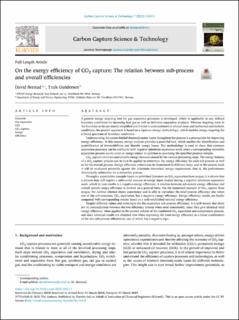| dc.description.abstract | A generic exergy targeting tool for gas separation processes is developed, which is applicable to any defined boundary conditions for incoming feed gas as well as delivered separation products. Whereas targeting tools in the literature so far are mostly simplified and limited to post-combustion related cases and isothermal and isobaric conditions, the present approach is based on a rigorous exergy methodology, which enables exergy targeting for a broad spectrum of boundary conditions.
Understanding the causes behind thermodynamic losses throughout the process is a prerequisite for improving energy efficiency. In this respect, exergy analysis provides a powerful tool, which enables the identification and quantification of irreversibilities and thereby exergy losses. The methodology is used to show that common separation processes can be attributed with negative minimum separation work, since a corresponding reversible separation process would yield an exergy output in addition to providing the specified product streams.
CO2 capture involves considerable energy demand caused by the various processing steps. The exergy balance of a CO2 capture process can in turn be applied to determine the exergy efficiency for each sub-process as well as for the overall process. Exergy efficiency criteria can be formulated in different ways, and in the present work it will be evaluated primarily against the minimum theoretical exergy requirement, that is, the performance theoretically achievable for a reversible process.
Through a quantitative example based on published literature on CO2 separation from syngas, it is shown that a process may still require a substantial amount of exergy input despite having a negative minimum separation work, which in turn results in a negative exergy efficiency. A relation between sub-system exergy efficiency and overall system exergy efficiency is derived on a general basis. For the numerical example of CO2 capture from syngas, the derived relation shows consistency and is able to reproduce the total process efficiency also when one of the sub-processes, CO2 separation, has a negative exergy efficiency. Exergy efficiency results are finally compared with corresponding results based on a well-established rational exergy efficiency.
Despite different values and even signs for the separation sub-process efficiency, it is still shown that there are no contradictions between the two efficiency criteria when used consistently, since they give identical total exergy efficiency when applied to the control volume of the combined CO2 separation and compression process, and since identical results are obtained also when expressing the total exergy efficiency as a linear combination of the two sub-process efficiencies, one of which has a negative sign. | en_US |

